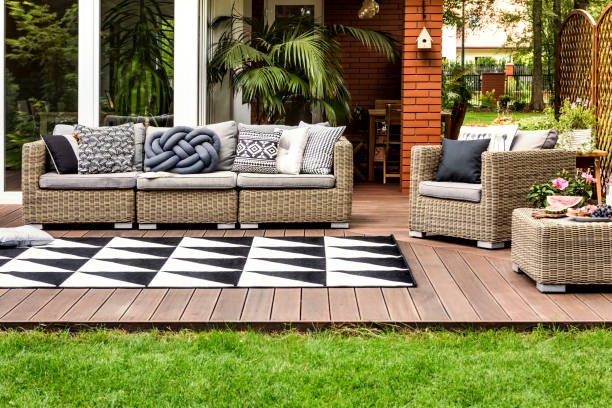Rugs are more than just functional floor coverings; they're opportunities for self-expression and creativity in home decor. While store-bought rugs offer convenience, crafting your rug allows you to personalize your space and showcase your crafting skills. In this article, we'll explore the world of DIY rug projects, from simple techniques to intricate designs, and discover how you can craft your unique floor coverings to elevate your home decor.
The Appeal of DIY Rug Projects
DIY rug projects hold a special allure for home decorators and craft enthusiasts alike. Here's why:
Personalization and Customization
Crafting your rug allows you to tailor every aspect to suit your style and preferences. From choosing the materials and colors to designing the pattern and size, DIY rugs offer unparalleled opportunities for customization, ensuring that your rug reflects your unique taste and personality.
Cost-Effectiveness
DIY rug projects can be more budget-friendly than purchasing a pre-made rug, especially if you repurpose materials or use affordable materials like yarn, fabric scraps, or rope. With a bit of creativity and resourcefulness, you can create stunning rugs at a fraction of the cost of store-bought alternatives.
Creative Expression
Rug-making is a versatile craft that allows for endless creativity and experimentation. Whether you prefer traditional weaving techniques, modern tufting methods, or innovative fabric manipulation, DIY rug projects offer a canvas for expressing your artistic vision and exploring new techniques.
DIY Rug Techniques and Ideas
There are countless DIY rug techniques and ideas to explore, ranging from beginner-friendly projects to more advanced designs. Here are a few to inspire your creativity:
Loom Weaving
Loom weaving is a classic rug-making technique that involves interlacing yarn or fabric strips on a loom to create intricate patterns and textures. While traditional floor looms require specialized equipment, smaller weaving frames or DIY cardboard looms offer accessible alternatives for beginners. Experiment with different yarns, colors, and weaving patterns to design one-of-a-kind rugs that add warmth and texture to your space.
Rag Rug Crochet
Rag rug crochet is a sustainable and eco-friendly way to repurpose old fabric scraps into beautiful rugs. Using a large crochet hook and strips of fabric cut from old T-shirts, bed linens, or jeans, you can create sturdy and durable rugs with unique color combinations and textures. Rag rug crochet is an ideal project for recycling materials and reducing waste while adding a cozy and rustic touch to your home decor.
Punch Needle Tufting
Punch needle tufting, also known as rug tufting, is a modern rug-making technique that allows for the creation of plush and tactile rugs with intricate designs. Using a punch needle tool and fabric backing, you can loop yarn or wool roving through the fabric to form raised pile loops, creating patterns and textures with varying heights and densities. Punch needle tufting is a versatile and forgiving technique that's suitable for beginners and experienced crafters alike, offering endless possibilities for creativity and design.
Painted Canvas Rugs
For a quick and easy DIY rug project, consider painting a canvas rug using stencils or freehand designs. Start with a plain canvas drop cloth or rug canvas, then use fabric paint or acrylic paint to add colorful patterns, motifs, or geometric designs. Painting your rug allows for complete artistic freedom and customization, allowing you to create bold and eye-catching floor coverings that serve as focal points in your home decor.
Tips for Successful DIY Rug Projects
While DIY rug projects offer limitless creative potential, they also require careful planning and execution to achieve professional-looking results. Here are some tips to ensure success:
- Choose the Right Materials: Select durable and suitable materials for your rug project, considering factors such as traffic levels, ease of maintenance, and aesthetic preferences.
- Plan Your Design: Sketch out your rug design and color scheme before starting the project to ensure a cohesive and harmonious result. Consider the scale of the pattern, placement of motifs, and overall visual impact.
- Take Your Time: Rug-making is a labor-intensive process that requires patience and attention to detail. Take your time to master techniques, troubleshoot problems, and enjoy the creative journey.
- Experiment and Innovate: Don't be afraid to experiment with new techniques, materials, and design ideas. Embrace mistakes as learning opportunities and use them to fuel your creativity and innovation.
- Finish and Protect Your Rug: Once your rug is complete, take steps to finish and protect it for long-lasting durability. Depending on the materials used, this may involve applying a protective sealant, adding a non-slip backing, or securing loose ends.
Conclusion
DIY rug projects offer a rewarding and fulfilling way to enhance your home decor while expressing your creativity and individuality. Whether you're a novice crafter or a seasoned artisan, there's a DIY rug technique and idea to suit every skill level and style preference. From loom weaving and rag rug crochet to punch needle tufting and painted canvas rugs, the possibilities are endless for crafting your unique floor coverings that add warmth, texture, and personality to your living space. With careful planning, creativity, and a willingness to experiment, you can embark on a rug-making journey that transforms your home into a showcase of handmade charm and style.
Along with a perfect mirror, adding rugs and a sideboard buffet can help in enhancing the look of your home.


No comments yet